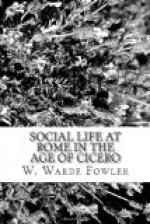Below it the hero is shown the shrine of the prophetic nymph Carmenta, with the Porta Carmentalis leading into the Campus Martius; then the hollow destined one day to be the Forum Romanum, and beyond it, in the valley of the little stream that here found its way down from the plain beyond, the grove of the Argiletum. Here, and up the slope of the Clivus sacer, with which we shall presently make acquaintance, were the lowing herds of Evander, who then takes his guest to repose for the night in his own dwelling on the Palatine, the site of the most ancient Roman settlement.[4]
What Evander showed to his visitor, as we shall presently see, comprised the whole site of the heart and life of the city as it was to be, all that lay under the steep sides of the three almost isolated hills, the Capitoline, Palatine, and Aventine. The poet knew that he need not extend their walk to the other so-called hills, which come down as spurs from the plain of the Campagna,—Quirinal, Esquiline, Caelian. Densely populated as those were in his own day, they were not essential organs of social and politics life; the pulse of Rome was to be felt beating most strongly in the space between them and the river where too the oldest and most cherished associations of the Roman people, mythical and historical, were fixed. I propose to take the reader, with a single deviation, over the same ground, and to ask him to imagine it as it was in the period with which we are concerned in this book. But first, in order to take in with eye and mind the whole city and its position, let us leave Aeneas, and crossing to the right bank of the Tiber by the Pons Aemilius,[5] let us climb to the fort of the Janiculum, an ancient outwork against attack from the north, by way of the via Aurelia, and here enjoy the view which Martial has made forever famous:
Hinc septem dominos videre montes
Et totam licet aestimare Romam,
Albanos quoque Tusculosque colles
Et quodcunque iacet sub urbe frigus.
No one who has ever stood on the Janiculum, and looked down on the river and the city, and across the Latin plain to the Alban mountain and the long line of hills—the last spurs of the Apennines—enclosing the plain to the north, can fail to realise that Rome was originally an outpost of the Latins, her kinsmen and confederates, against the powerful and uncanny Etruscan race who dwelt in the undulating hill country to the north. The site was an outpost, because the three isolated hills make it a natural point of defence, and of attack towards the north if attack were desirable; no such point of similar vantage is to be found lower down the river, and if the city had been placed higher up, Latium would have been left open to attack,—the three hills would have been left open to the enemy to gain a firm footing on Latin soil. It was also, as it turned out, an admirable base of operations for carrying on war in the long and narrow peninsula, so awkward, as Hannibal




